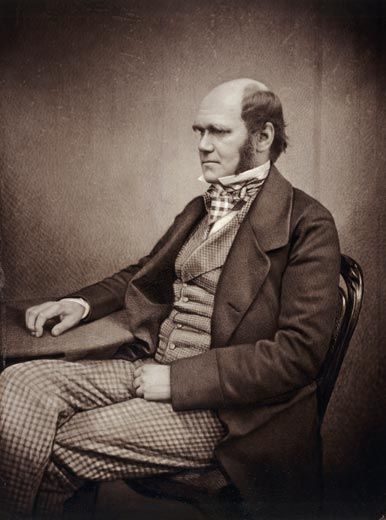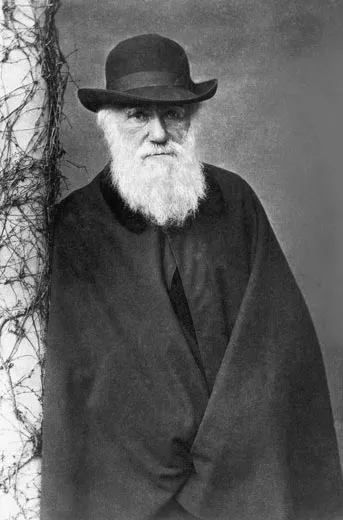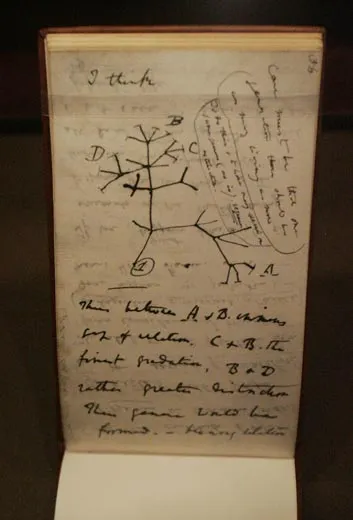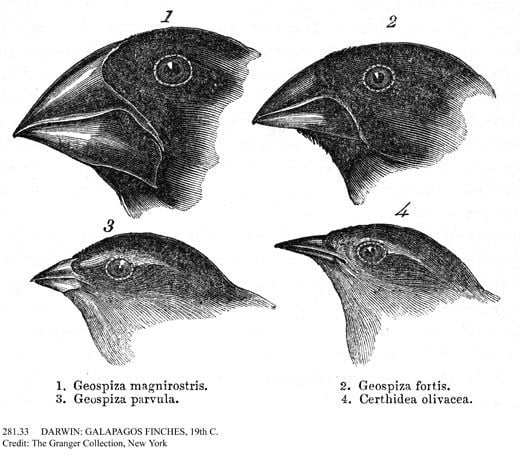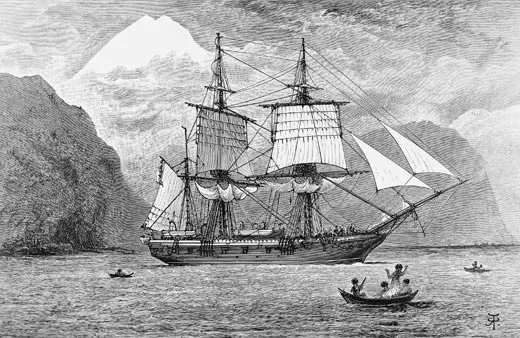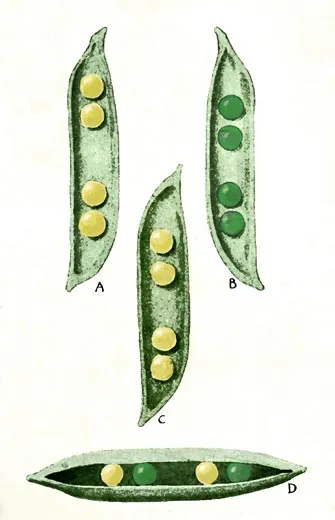What Darwin Didn’t Know
Today’s scientists marvel that the 19th-century naturalist’s grand vision of evolution is still the key to life
/https://tf-cmsv2-smithsonianmag-media.s3.amazonaws.com/filer/Charles-Darwin-1880-631.jpg)
Charles Darwin was just 28 years old when, in 1837, he scribbled in a notebook "one species does change into another"—one of the first hints of his great theory. He'd recently returned to England after his five-year journey as a naturalist aboard the HMS Beagle. In South America, Oceania and most memorably the Galápagos Islands, he had seen signs that plant and animal species were not fixed and permanent, as had long been held true. And it was as if he had an inkling of the upheavals to come as he pored over specimens he had collected and others had sent him: finches, barnacles, beetles and much more. "Cuidado," he wrote in another notebook around that time, using the Spanish word for "careful." Evolution was a radical, even dangerous idea, and he didn't yet know enough to take it public.
For another 20 years he would amass data—20 years!—before having his idea presented publicly to a small audience of scientists and then, a year later, to a wide, astonished popular readership in his majestic On the Origin of Species, first published in 1859. Today, Origin ranks among the most important books ever published, and perhaps alone among scientific works, it remains scientifically relevant 150 years after its debut. It also survives as a model of logical thought, and a vibrant and engaging work of literature.
Perhaps because of that remarkable success, "evolution," or "Darwinism," can sometimes seem like a done deal, and the man himself something of an alabaster monument to wisdom and the dispassionate pursuit of scientific truth. But Darwin recognized that his work was just the beginning. "In the distant future I see open fields for far more important researches," he wrote in Origin.
Since then, even the most unanticipated discoveries in the life sciences have supported or extended Darwin's central ideas—all life is related, species change over time in response to natural selection, and new forms replace those that came before. "Nothing in Biology Makes Sense Except in the Light of Evolution," the pioneering geneticist Theodosius Dobzhansky titled a famous essay in 1973. He could not have been more right—evolution is quite simply the way biology works, the central organizing principle of life on earth.
In the 150 years since Darwin published Origin, those "important researches" have produced results he could never have anticipated. Three fields in particular—geology, genetics and paleoanthropology—illustrate both the gaps in Darwin's own knowledge and the power of his ideas to make sense of what came after him. Darwin would have been amazed, for example, to learn that the continents are in constant, crawling motion. The term "genetics" wasn't even coined until 1905, long after Darwin's death in 1882. And though the first fossil recognized as an ancient human—dubbed Neanderthal Man—was discovered in Germany just before Origin was published, he could not have known about the broad and varied family tree of ancestral humans. Yet his original theory has encompassed all these surprises and more.
Around the world, people will celebrate Darwin's 200th birthday with lectures, exhibits and festivities. In England, where Darwin already graces the ten-pound note, a special two-pound coin will be struck. Cambridge University is hosting a five-day festival in July. In North America, Darwin events are scheduled in Chicago, Houston and Denver, among many other places. Smithsonian's National Museum of Natural History established an "Evolution Trail" that highlights concepts from Darwin's work throughout the museum, and a special exhibit shows how orchids have evolved and adapted according to Darwin's theory.
As towering historical figures go, Charles Darwin does not provide much by way of posthumous scandals. The liberty-extolling Thomas Jefferson was slave master to his longtime mistress, Sally Hemings; Albert Einstein had his adulterous affairs and shockingly remote parenting style; James Watson and Francis Crick minimized their debt to colleague Rosalind Franklin's crucial DNA data. But Darwin, who wrote more than a dozen scientific books, an autobiography and thousands of letters, notebooks, logs and other informal writings, seems to have loved his ten children (three of whom did not survive childhood), been faithful to his wife, done his own work and given fair, if not exuberant, credit to his competitors.
He was born in Shrewsbury, England, on February 12, 1809, into a well-off family of doctors and industrialists. But his up-bringing wasn't entirely conventional. His family was active in progressive causes, including the antislavery movement. Indeed, an illuminating new book by Adrian Desmond and James Moore, Darwin's Sacred Cause, concludes that Darwin's interest in evolution can be traced to his, and his family's, hatred of slavery: Darwin's work proved the error of the idea that the human races were fundamentally different. Both of his grandfathers were famous for unorthodox thinking, and Darwin's mother and physician father followed in those footsteps. Darwin's paternal grandfather, Erasmus Darwin, was a physician and natural philosopher of vast appetites—and correspondingly corpulent physique—who developed his own early theory of evolution. (It was more purely conceptual than Charles' and missed the idea of natural selection.) On his mother's side, Darwin's grandfather was the wealthy Josiah Wedgwood, founder of the eponymous pottery concern and a prominent abolitionist.
Darwin began training to be a physician but didn't have a taste for doctoring, so he moved on to studying for the Anglican priesthood at Cambridge. His real passion, however, was natural history. Shortly after graduation in 1831, he signed on for an unpaid position as a naturalist aboard the Beagle, which was about to embark on a survey of South American coastlines. During the five-year voyage Darwin collected thousands of important specimens, discovered new species both living and extinct and immersed himself in biogeography—the study of where particular species live, and why.
Upon his return to England in 1836, Darwin stayed busy, publishing scientific works on the geology of South America, the formation of coral reefs and the animals encountered during his Beagle expedition, as well as a best-selling popular account of his time aboard the ship. He married his cousin, Emma Wedgwood, in 1839, and by 1842 the growing Darwin family was established at Down House, in a London suburb. Charles, plagued by poor health, settled down with a vengeance.
By 1844, he was confiding in a letter to a fellow naturalist, "I am almost convinced (quite contrary to opinion I started with) that species are not (it is like confessing a murder) immutable." Still, he hesitated to publicize the idea, instead plunging into the study of domestic animal breeding—natural selection, he would argue, is not unlike the artificial selection practiced by a breeder trying to enhance or eliminate a trait—and the distributions of wild plants and animals. He devoted eight full years to documenting minute anatomical variations in barnacles. A prolific letter writer, he sought samples, information and scientific advice from correspondents around the world.
It was a young naturalist and professional specimen collector named Alfred Russel Wallace who finally spurred Darwin to publish. Working first in the Amazon and then in the Malay Archipelago, Wallace had developed an evolution theory similar to Darwin's but not as fully substantiated. When, in 1858, Wallace sent the older man a manuscript describing his theory of evolution, Darwin realized that Wallace could beat him into print. Darwin had an essay he had written in 1844 and Wallace's manuscript read at a meeting of the Linnean Society in London on July 1, 1858, and published together later that summer. Wallace, then on an island in what is now Indonesia, wouldn't find out about the joint publication until October. "There's been an argument about whether Wallace got screwed," says Sean B. Carroll, a biologist and author of books on evolution. "But he was delighted. He was honored that his work was considered worthy" to be included alongside that of Darwin, whom he greatly admired.
This first public airing of Darwinian evolution caused almost no stir whatsoever. But when Darwin published his ideas in book form the following year, the reaction was quite different. On the Origin of Species by Means of Natural Selection, or the Preservation of Favoured Races in the Struggle for Life soon sold out its first press run of 1,250 copies, and within a year some 4,250 copies were in circulation. Allies applauded it as a brilliant unifying breakthrough; scientific rivals called attention to the gaps in his evidence, including what would come to be known as "missing links" in the fossil record; and prominent clergymen, politicians and others condemned the work and its far-reaching implications. In 1864 Benjamin Disraeli, later Britain's prime minister, famously decried the idea—barely mentioned in Origin—that human beings too had evolved from earlier species. "Is man an ape or an angel?" he asked rhetorically at a conference. "I, my lord, I am on the side of the angels. I repudiate with indignation and abhorrence those newfangled theories."
Darwin had anticipated such protests. "Any one whose disposition leads him to attach more weight to unexplained difficulties than to the explanation of a certain number of facts will certainly reject my theory," he wrote in Origin. But, he also said, "I look with confidence to the future, to young and rising naturalists, who will be able to view both sides of the question with impartiality."
The age of the earth was, for Darwin, a major unexplained difficulty. He recognized that a great deal of time must have been necessary for the world's diversity of plants and animals to evolve—more time, certainly, than the 6,000 years allowed by the leading biblical interpretation of earth's age, but more also than many scientists then accepted. In 1862, the physicist William Thomson (later Lord Kelvin) calculated that the planet was unlikely to be more than 100 million years old—still nowhere near enough time for evolution to have acted so dramatically. "Thomson's views on the recent age of the world have been for some time one of my sorest troubles," Darwin wrote to Wallace in 1869. Further studies, including one by Darwin's son George, an astronomer, fixed earth's age at well under 100 million years.
It wouldn't be until the 1920s and 1930s that geologists, calculating the rates of radioactive decay of elements, concluded that the earth was billions of years old—according to the latest studies, 4.5 billion years. Darwin surely would have been relieved that there was enough time for evolution to have accounted for the great diversity of life on earth.
Modern geology has helped solve another puzzle that troubled Darwin—the existence of oddly similar terrestrial species on separate continents. How, for example, to explain the emus of Australia, ostriches of Africa and rheas of South America— large, flightless, long-necked birds with the same distinctive sternums? Early evolutionists, following Darwin, invoked scenarios such as long-gone land bridges stretching thousands of miles to explain how apparently related species could wind up so far apart. The outrageous truth wasn't revealed until the 1960s, when scientists discovered plate tectonics and confirmed that the continents, far from being permanent fixtures of land surrounded by water, were giant rafts floating on molten rock. This discovery justified the nagging suspicion of middle school students everywhere that the continents should fit together into a giant jigsaw puzzle, as indeed they once had. In Darwin's time, the idea that once-contiguous continents shifted apart, separating sister species one from another, would have been nearly as audacious as evolution itself.
Evolution explains the vast diversity of life on earth, with single species becoming many as they adapt to different environments. "Remarkably," says the evolutionary biologist Edward O. Wilson, "although his masterwork was entitled On the Origin of Species, Darwin really didn't pay much attention to how one species splits and multiplies into many." Darwin did acknowledge the importance of this process, called speciation, at the very end of Origin: "Life, with its several powers, having been originally breathed into a few forms or into one...whilst this planet has gone cycling on according to the fixed law of gravity, from so simple a beginning endless forms most beautiful and most wonderful have been, and are being, evolved." But, says Wilson, Darwin focused on "how one species was transformed by some force or other into another species through time, not how species could multiply."
Darwin's famous Galápagos finches—more than a dozen species all descended from the same South American ancestor—would become the iconic example of speciation. But understanding the process would have to wait for the work of Wallace in the mid-1860s. "Wallace clearly expressed [speciation] in a major study made of butterflies of the Malay Archipelago," Wilson says. Wallace, working in an area with tens of thousands of islands, showed that a single butterfly species could slowly become many as it adapted to the specific conditions encountered on each island. "From then on biologists put more time into thinking about multiplication of species," Wilson says, "and by the turn of the century they had a pretty clear idea of how species originate. But that was something that Darwin held back a little."
Darwin knew that plant and animal species could be sorted into groups by similarity, such that birds clustered into songbirds and raptors, say, with each group subdivided again and again down to dozens or hundreds of distinct species. He also saw that the individuals within any given species, despite many similarities, also differed from one another—and some of those differences were passed from parents to their offspring. And Darwin observed that nature had a brutally efficient method of rewarding any variation that helped an individual live longer, breed faster or leave more progeny. The reward for being a slightly faster or more alert antelope? The lions would eat your slower neighbors first, granting you one more day in which to reproduce. After many generations and a great deal of time, the whole population would run faster, and with many such changes over time eventually become a new species. Evolution, Darwin's "descent with modification through natural selection," would have occurred.
But what was the source of variation and what was the mechanism for passing change from generation to generation? Darwin "didn't know anything about why organisms resemble their parents, or the basis of heritable variations in populations," says Niles Eldredge, a paleontologist at the American Museum of Natural History in New York City.
In Darwin's era, the man who did make progress on the real mechanism of inheritance was the Austrian monk Gregor Mendel. In his abbey garden in the late 1850s and early 1860s, Mendel bred pea plants and found that the transmission of traits such as flower color and seed texture followed observable rules. For instance, when plants with certain distinct traits were bred with each other, the hybrid offspring did not have a trait that was a blend of the two; the flowers might be purple or white, but never an intermediate violet. This surprising result helped point the way toward the concept of "units" of inheritance—discrete elements of hereditary information. An offspring inherits a set of these genetic units from each parent. Since the early 1900s, those units of inheritance have been known as genes.
Mendel knew Darwin's work—his German copy of Origin was sprinkled with handwritten notes—but there's no evidence that Mendel realized that his units of inheritance carried the variation upon which Darwinian selection acted. "The interesting thing is that Mendel had both pieces of the puzzle in his hands, but he never put it together," says Michael Ruse, a historian and philosopher of science at Florida State University. "He never once said, 'Ah hah, I've got the answer to Darwin's problem.'" Mendel's discoveries remained obscure until after he died in 1884, and Darwin never knew of them. But what if he had? "If Darwin had read Mendel's papers, he might have picked up on it," Ruse says, "but I'm not sure it would have made much difference."
Today, comparative genomics—the analysis of whole sets of genetic information from different species—is confirming the core of Darwin's theory at the deepest level. Scientists can now track, DNA molecule by DNA molecule, exactly what mutations occurred, and how one species changed into another. (In one particularly fitting example, researchers are now working out the molecular changes that allowed Darwin's Galápagos finches to evolve different beaks in response to their different feeding strategies.) Darwin himself made a stab at drawing a "tree of life," a diagram that traces the evolutionary relationships among species based on their similarities and differences. But scientists are now constructing the most detailed tree of life ever, as part of the Encyclopedia of Life project (sponsored in part by the Smithsonian Institution), using DNA sequence data as well as traditional anatomical and behavioral characteristics to trace the precise evolutionary relationships among thousands and thousands of species.
There have been plenty of evolutionary surprises in recent years, things that Darwin never would have guessed. The number of genes a species has doesn't correlate with how complex it is, for example. With some 37,000 genes, rice has almost twice as many as humans, with 20,000. And genes aren't passed only from parent to offspring; they can also be passed between individuals, even individuals of different species. This "horizontal transfer" of genetic material is pervasive in bacteria; it's how antibiotic resistance often spreads from one strain to another. Animals rarely acquire whole genes in this way, but our own DNA is packed with smaller bits of genetic material picked up from viruses during our evolutionary history, including many elements that regulate when genes are active or dormant.
Do these surprises challenge the central idea of Darwinian evolution? "Absolutely not," says David Haussler, a genome scientist at the University of California at Santa Cruz. "I am struck with the fact daily that the more information we accumulate, the more validation we find of Darwin's theory." Once new material has nestled into a host's genome via horizontal transfer, the genetic material is as subject to natural selection as ever. Truly one of the most remarkable traits of Darwinism itself is that it has withstood heavy scientific scrutiny for a century and a half and still manages to accommodate the latest ideas. "So far the data sets we've looked at and the surprises we've found show that the essence of the idea is right," Haussler says.
Another growing field of biology is shedding further light on the origins of variation. Evolutionary developmental biology, or evo-devo, focuses on changes in the exquisitely choreographed process that causes a fertilized egg to mature. Behind one series of such changes are the so-called homeotic genes, which dictate where legs or arms or eyes will form on a growing embryo. These central-control genes turned out to be almost identical even in animals as different as worms, flies and human beings. Many researchers now think that much of evolution works not so much through mutations, or random errors, in the major functional genes, but by tweaking the ways by which developmental genes control other genes.
"The building blocks of squids and flies and humans and snakes are stunningly similar," says Carroll, of the University of Wisconsin at Madison, one of the founders of evo-devo. "It kind of upsets your worldview at first," he adds, "but then you see that it bolsters the Darwinian view a thousandfold. These kinds of connections were at the heart of descent with modification."
Carroll says he thinks Darwin would be thrilled with the evolutionary details scientists can now see—how, for example, changes in just a small number of regulatory genes can explain the evolution of insects, which have six legs, from their ancestors, which had even more. From there, it's a short step to solving some of the mysteries of speciation, working out the mechanics of exactly how one species becomes many, and how complexity and diversity can be built up out of very simple beginnings. "I think this is a new golden age of evolutionary science," says Carroll. "But what we're really doing is fleshing out Darwin's idea in ever greater detail."
Perhaps the most surprising discovery in recent years has to do with one of Darwin's predecessors in evolutionary theory. Jean-Baptiste Lamarck, a French naturalist, developed his own theory of biological evolution in the early 19th century. He suggested that acquired traits could be passed along to offspring—giraffes that stretched to reach leaves on tall trees would produce longer-necked offspring. This "soft inheritance" became known as Lamarckism and soon proved susceptible to parody: Would clipping the tail off a rat lead to tailless pups? Of course not, and in time soft inheritance was dismissed, and Lamarck became a textbook example of shoddy thinking.
Then, in the early days of genetic engineering more than two decades ago, researchers inserted foreign genes into the DNA of lab animals and plants and noticed something strange. The genes inserted into such host cells worked at first, "but then suddenly they were silenced, and that was it, generation after generation," says Eva Jablonka, an evolutionary biologist at Tel Aviv University in Israel. Researchers figured out that the host cells were tagging the foreign genes with an "off switch" that made the genes inoperable. The new gene was passed to an animal's offspring, but so was the off switch—that is, the parent's experience influenced its offspring's inheritance. "Mechanisms that were at the time hypothetical proved to be real," says Jablonka, "and of course much more complicated than anyone thought, which is natural."
All sorts of changes in cellular machinery have shown up that have nothing to do with the sequence of DNA but still have profound, and heritable, impacts for generations to come. For example, malnourished rats give birth to undersized pups that, even if well fed, grow up to give birth to undersized pups. Which means, among other things, that poor old Lamarck was right—at least some acquired traits can be passed down.
Darwin included the concept of soft inheritance in Origin, mentioning "variability from the indirect and direct action of the external conditions of life, and from use and disuse," for example. It has been said that Darwin himself was not a particularly strict Darwinian, meaning that his work allowed for a wider variety of mechanisms than many of his 20th-century followers would accept. "In a way," says Jablonka, "we're going back to Darwin and his original, much broader notion of heredity."
Origin barely touched upon the most contentious evolutionary issue: If all life has evolved from "lower forms," does that include people? Darwin finally addressed the issue in The Descent of Man, and Selection in Relation to Sex, published in 1871, explaining he had been studying human evolution for years, but "with the determination not to publish, as I thought that I should thus only add to the prejudices against my views." How right he was, both that "man is the modified descendant of some pre-existing form"—and that an awful lot of people would prefer to believe otherwise. They shared Disraeli's discomfort at being descended from apes and complained that evolution pushed a divine creator to the side.
Disbelief in human descent may have been a justifiable comfort in Darwin's time, when few fossils of human ancestors had been discovered, but the evidence no longer allows it. Darwin, in Origin, admitted that the lack of "intermediate varieties" in the geological record was "the most obvious and gravest objection which can be urged against my theory."
The objection certainly applied to the paucity of ancestral human fossils in Darwin's time. Years of painstaking work by paleontologists, however, have filled in many of the important gaps. There are many more extinct species to be discovered, but the term "missing link" has for the most part become as outdated as the idea of special creation for each species. Anthropologists once depicted human evolution as a version of the classic "March of Progress" image—a straight line from a crouching proto-ape, through successive stages of knuckle draggers and culminating in upright modern human beings. "It was a fairly simple picture, but it was a simplicity born of ignorance," says biological anthropologist William Jungers of Stony Brook University in New York. "The last 30 years have seen an explosion of new finds."
There are now hundreds of known fossils, stretching back six to seven million years and representing about two dozen species. Some were our ancestors and others distant cousins. "There have been many experiments in human evolution," Jungers says, "and all of them but us have ended in extinction." Our direct ancestors evolved in Africa some 200,000 years ago and started spreading out perhaps 120,000 years later. Remarkably, our modern human forebears shared parts of Europe and western Asia with the Neanderthal species as recently as 30,000 years ago, and they may have also overlapped with two other long-gone ancient humans, Homo floresiensis and Homo erectus, in Southeast Asia. "We were never alone on this planet until recently," Jungers says.
Darwin himself was confident that the deep past would be revealed. "It has often and confidently been asserted, that man's origin can never be known," he wrote in 1871. "But ignorance more frequently begets confidence than does knowledge: it is those who know little, and not those who know much, who so positively assert that this or that problem will never be solved by science." He also recalled, looking back on the shellacking he took for focusing on natural selection's role in evolution, that "the future must decide" whether "I have greatly overrated its importance." Well, the future has come down solidly on Darwin's side—despite everything he didn't know.
Asked about gaps in Darwin's knowledge, Francisco Ayala, a biologist at the University of California at Irvine, laughs. "That's easy," he says. "Darwin didn't know 99 percent of what we know." Which may sound bad, Ayala goes on, but "the 1 percent he did know was the most important part."
Thomas Hayden is the co-author of the 2008 book Sex and War: How Biology Explains Warfare and Terrorism and Offers a Path to a Safer World.
